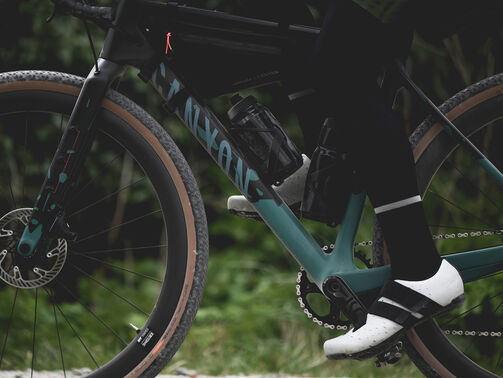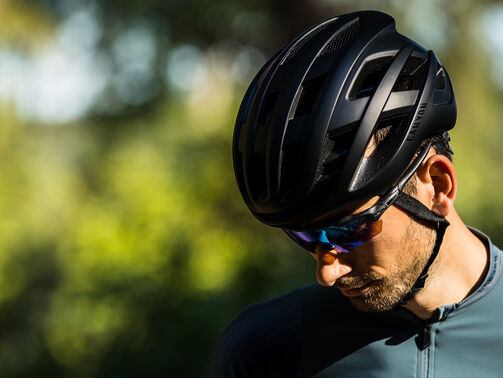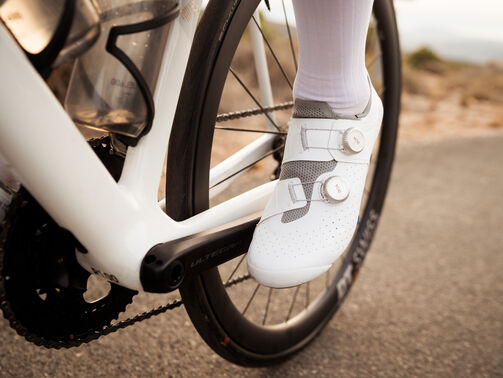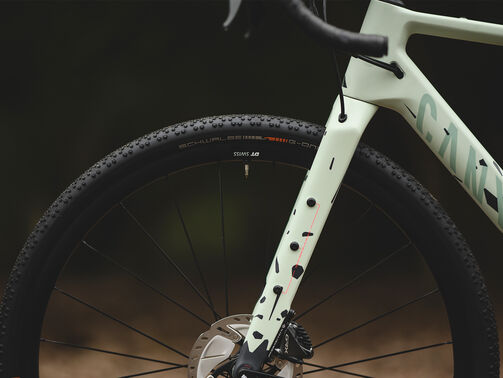How to choose the right bike saddle
Finding the best bike saddle can be a minefield. With help from Ergon, our guide will help you find comfort on the bike no matter where you ride.


Is there anything worse than being uncomfortable while riding your bike?
One of the main sources of discomfort while riding stems from having an ill-fitting bike saddle. Choosing the right bike saddle can be a time consuming exercise, but when you find the best fit, there'll be no stopping you.
Whether you're a road cyclist, mountain biker or occasional commuter, we'll guide you through the basics of finding the best bike saddle for each cycling discipline, explain why your own anatomy can affect that of the saddle itself and a word of warning against some common myths.
Finding the right saddle fit
Not all saddles were created equally and there is no one-size-fits-all approach. Everyone is different.
Saddles have their own anatomy and it should complement yours. The overall shape and size of one saddle can differ from one to the next. As the saying goes, "if at first you don't succeed, try and try again."
As a critical contact point with the bike, the right saddle is crucial to your comfort and performance. A well-fitting saddle won't hurt you and will enable you to achieve your goals on the bike. Whether it's simply getting to work in the morning or winning your next race, you should be free from discomfort while riding.
The easiest way to find the right saddle fit is to measure the width between your sit bones. Saddle manufacturers produce different models in different widths. A lot of local bike shops have a sit bone measuring device, so that you can easily find your measurements.
-

The sit bones of women -
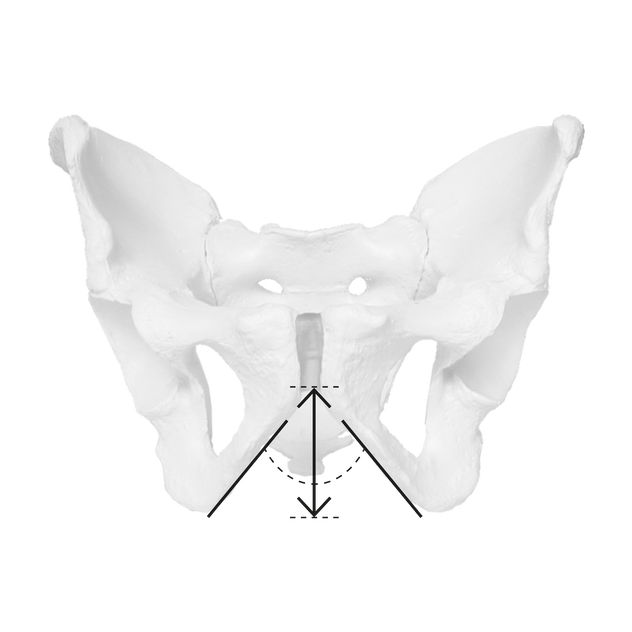
The sit bones of men
What causes saddle pain?
The main reason for saddle pain is too much pressure in the wrong places. Your riding position is an important factor in this.
Your saddle should support your sit bones in a balanced way. If your saddle is too wide, you'll end up with chafing. If your saddle is too narrow, your sit bones will have too much pressure on them.
When you're in the riding position, a woman's pubic bone arch or man's perineal area may also come into contact with the saddle. The angle of your saddle is crucial.
If the saddle is tilted too far forwards at the front, your hands will ache from keeping you perched on it. If the saddle is tilted too far backwards, you'll have too much pressure at the front of your pubic area as you reach for the handlebars.
Anatomy of a saddle
We know a saddle is for sitting on but what makes one saddle different from the next?
There are a few parts that make up a bike saddle:
- Cover material: leather or synthetic fabrics are common materials on the saddle cover.
- Shell: the hard base is what creates the flex in a saddle. The padding and cover sit on top of the shell. It can be made from plastic or carbon. Budget-friendly options tend to be plastic, while weight-weenies might want to splurge on a carbon saddle.
- Padding: some saddles have thick padding however this isn't often the solution to your comfort problems. A minimal but dense layer of foam will relieve pressure where it's needed. Some carbon saddles have no padding at all, but the majority of riders will prefer some support.
- Saddle rails: the points at which the saddle attaches to the seatpost can be metal alloy, titanium or carbon. Each has its benefits but will come at a different price point and weight.
- Saddle profile: curved or flat? Flatter saddles are designed for aerodynamic riding positions. Curved-profile saddles are better suited to more upright positions such as endurance riding, commuting and trail riding.
- Cut-outs: a saddle with a cut-out is designed to relieve pressure in the perineal area or pubic bone arch.
Myth: a new saddle should hurt. Wrong! A new saddle should be comfortable from the get go. While it might take a couple of rides to hone the position, you should not be wincing in pain every time you go out for a ride.
Do women's saddles differ from men's?
Some women are comfortable on a unisex saddle but a lot of women prefer to ride on a women's specific saddle.
The difference between male and female anatomy is the main driver behind the different models. A women's saddle will have a different shape which can include a cut-out and different foam densities.
Jenny Haas is the Team Lead Ergonomics (R&D) at Ergon, a leading manufacturer of saddles. She and her team are passionate about educating riders on this matter.
“At Ergon we have three important factors to find the perfect saddle: riding position/bike type, sit bone width and gender,” she says before diving into detail on the topic of gender.
“The female genital area is “immobile” so we sit on our genitals while cycling, especially in a sporty/aggressive position,” Jenny explains. “That is why the shape of our women’s saddles and the pressure relief zone differ from our men’s saddles in order to support the bony structures and decrease pressure in the soft tissue areas.”
As with any saddle, the main aim is to be comfortable and supportive. The saddle should relieve pressure around soft tissue areas and these areas typically differ between men and women.
-
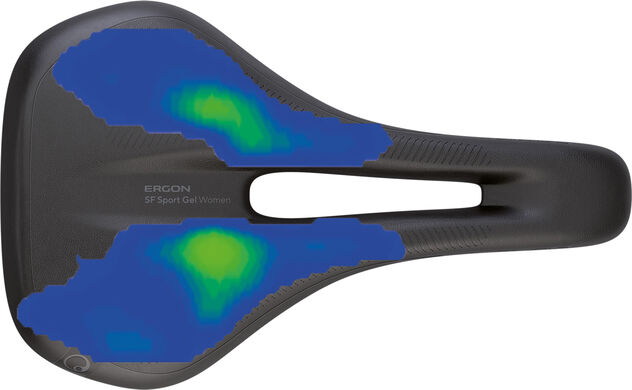
The pressure map of women -
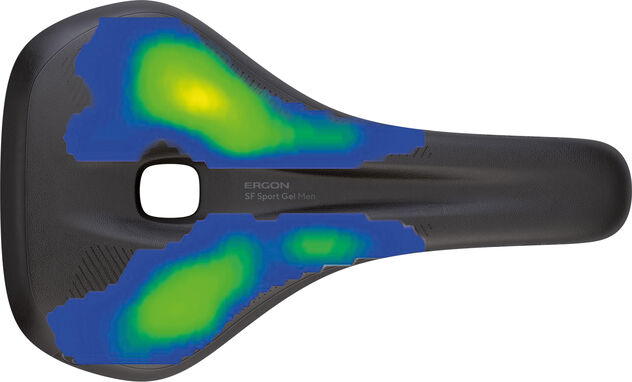
The pressure map of men
Choosing the right saddle for you
One Google search for "bike saddle" will return a million results. The perfect saddle will mean you can ride in comfort for days, weeks and years to come. The wrong saddle will have you turning around within minutes and suffering the consequences for hours afterwards.
So how do you find the right saddle for you?
1. What type of cycling do you do?
Depending on the type of riding you do, you might find you need a different saddle for each bike. The saddle on your road bike will rarely be the same saddle you have on your downhill mountain bike.
If you race time trials, you'll have a very aggressive riding position that commands a flatter saddle profile and short nose, for example.
If you're out on your mountain bike, a wider curved saddle might offer more comfort while you're out shredding the trails. Some saddles are even optimised to absorb vibrations from the trails beneath them.
2. Are you male or female?
Your anatomy matters. As we explained earlier, you may benefit from a women's specific saddle.
That said, plenty of women find comfort on a unisex saddle. It's also not unheard of for men to be comfortable on a women's saddle.
3. Measure your sit bones
The easiest way to determine your saddle size is by measuring your sit bones. Most brands offer a range of models in a range of widths.
Pressure mapping is also available from many bike fitters. This involves sitting on a piece of fabric hooked up to a computer. It will display the highest pressure points on the saddle and help you make changes to relieve the heavy pressure sites.
4. Find a saddle library or go for a test ride
Saddle libraries stock a range of saddles from many different brands. The idea is you can borrow a saddle for a period of time and return it after you're finished testing it.
Some bike shops offer a testing service on the saddle brands they stock. Head down to your local bike shop for more information.
5. Consider your budget
Your budget is an important factor when shopping for a bike saddle. If you're willing to spend more, you'll have a lot more options available to you such as lightweight carbon saddles and 3D printed options.
Though it isn't strictly necessary to have the lightest, most innovative saddle, some riders may want that. You may also find that you don't get along with the most expensive saddles and a more affordable alternative works perfectly.
Tweaking your saddle position
Once you've settled on a comfortable saddle, you should know how to fit it properly. A lot of riders find that a level saddle is most comfortable as it offers an even pressure across your body. Others find they need to tilt it ever so slightly for the desired result.
A professional bike fit can help with all your questions relating to saddle fit and the fit of your bike as a whole.
If you're fitting it yourself, remember to wear the kit you usually ride in such as bib shorts and cycling shoes. This will affect the saddle height.
Good chamois means good comfort
The saddle isn’t the only important factor when increasing your comfort on the bike. Jenny Haas emphasises the importance of high quality chamois pads. “There are so many different options in terms of shape, thickness, density etc. and it needs to suit the rider as well as the saddle shape,” she explains.
Canyon’s range of shorts and bib shorts have been tested extensively to offer supreme comfort. Check out our buyer’s guide to bib shorts for more information.
The low down on saddles
Now you know how to find the best bike saddle. Measure your sit bones and do your research. Try before you buy if possible and enjoy riding your bike. If in doubt, seek a professional bike fit to help you hone your riding position.
Discover Canyon's range of bike saddles
Did this article help?
Thank you for your feedback


